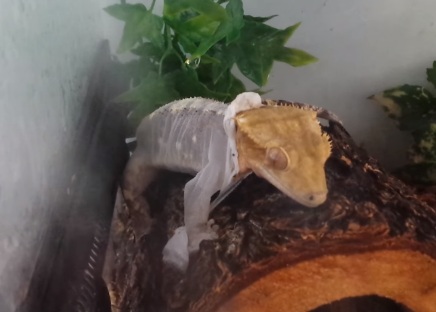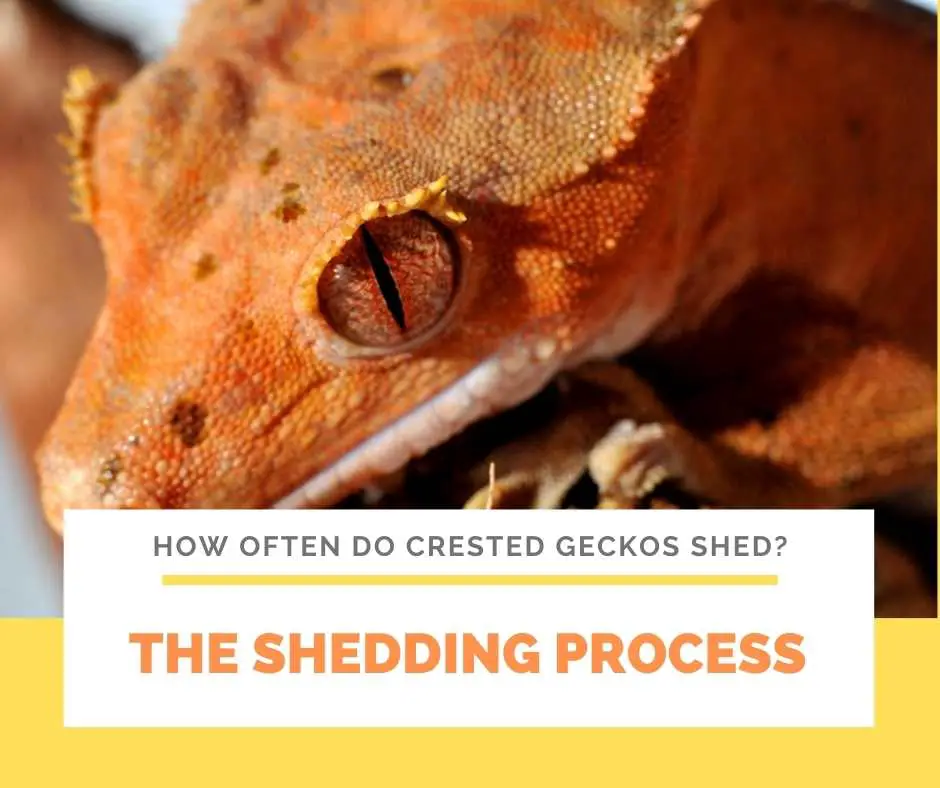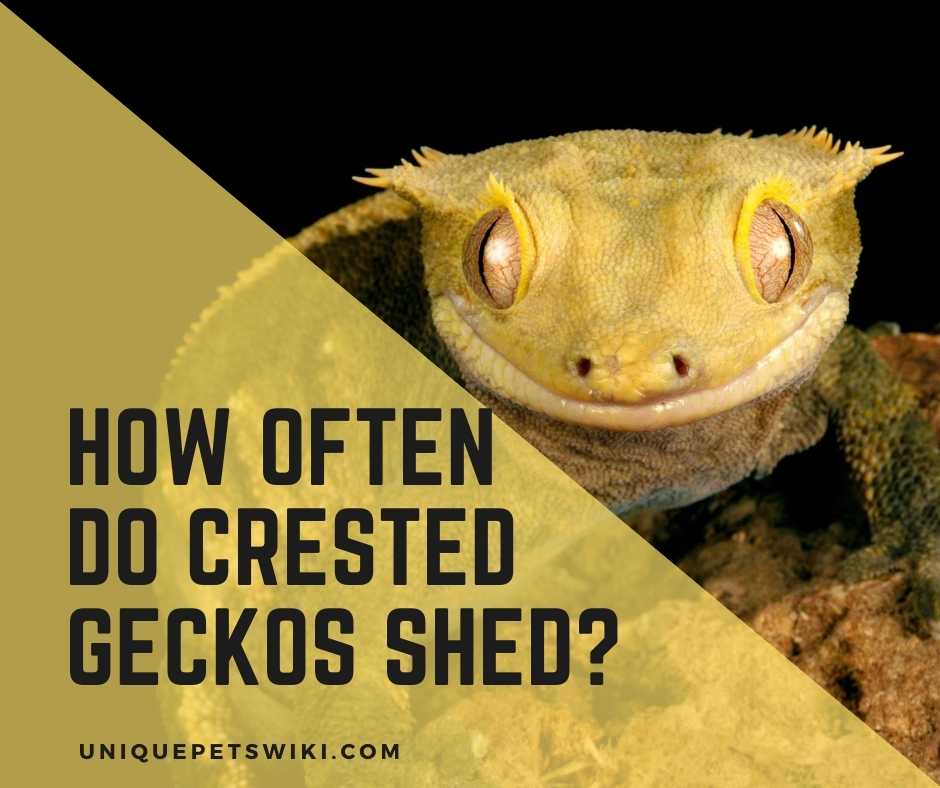Like most reptiles, one of the crested geckos’ facts that they do shed their skin regularly. Since shedding is a natural process, crested geckos will not have trouble when shedding. Crested geckos do shed their skin to continue growing properly and to get a new skin.
Adult cresties normally shed about once a month while young cresties shed their skin once every two weeks. However, you may not see your gecko shedding because they shed at night and are done within 15-20 minutes.
In this article, you will get an insight into the shedding process of crested geckos, how often do crested geckos shed, and the problems they can encounter when shedding.
Contents
Crested Geckos Shedding

Crested geckos’ skin comprises two large layers, namely the dermis and the epidermis. The skin’s outer layer is the epidermis, and new cells are usually continuously created at the bottom of it. These new cells are filled with keratin, a protein that gives protection and prevents water loss.
The keratin will then die off when the new skin cells are fully grown. This is why the old and dead skin needs to be replaced by new skin. Unlike human skin cells, cresties’ old and dead skin will come off as a whole layer.
However, there are cases where the dead layer breaks in pieces, and the shedding process will happen in stages. The shedding process in reptiles is known as ecdysis, and it is associated with the growth of crested geckos.

Signs of Shedding
The major way to tell that your crested gecko is shedding is when you see old dead skin coming off your crested geckos. However, there are some signs that you can be on the lookout for to let you know that your gecko is about to shed. Some of them are stated below.
- Pale color
- Your geckos have problems sticking to their enclosure walls.
- Loss of appetite.
New to crested gecko? Check out the crested gecko care sheet now! We had listed out all the things you need to know about crested gecko as pets. Check it now!
How Often Do Crested Geckos Shed?

Because hatchling crested geckos grow rapidly, they will shed their skin weekly. However, baby & juvenile crested geckos shed their skin every two weeks while the adult geckos will shed their skin every two weeks to a month.
Shedding is related to the crested gecko’s growth and it occurs more frequently in young crested geckos. This means hatchling cresties will shed more often than a juvenile gecko, while juvenile will shed their skin more frequently than the adult.
Note: Every crested gecko is different, and the shedding process will be affected by your crested geckos’ growth rate. Your cr estie can take longer or faster to shed instead of the time stated above. You may also not know when your crestie sheds because they will eat their skin immediately.
How Do Crested Geckos Shed?

After shedding new skin, crested geckos will consume their old skin. It will start to lick off the skin ready for shedding from the snout, and starts chewing it off the rest of the body.
During the shedding process of crested geckos, there is a need for proper humidity and hydration for a complete shed. You will also need to regularly check your gecko to ensure that the shed is complete.
You should ensure you do not miss the areas around the toes and tip of the tail. This is because any skin left in the area can restrict blood flow and cause their toes or tail tip to die and fall off.
Note: Shedding process is usually stressful and requires a lot of nutrients. This is the reason why crested geckos eat their sheds to replenish some nutrients. Eating of sheds is a normal process, and you should not be surprised if you find our gecko eating its shed.
Crested Gecko Shedding & Common Problems
There are times when crested geckos can have trouble with shedding. Shedding problems can either be in small patches or one big part of the skin. The scientific name used for skin shedding issues in reptiles is called dysecdysis.
Several different reasons can cause shedding problems; however, some can be more serious than others.
Causes of Shedding Problems in Crested Geckos
Although most crested geckos don’t usually have a problem with shedding their skin. However, there are times when your crested geckos may need extra help during shedding. Some of the following reasons can cause shedding problems.
Improper Living Conditions
One of the common reasons for shedding problems in crested geckos is low humidity. Crested needs a relative humidity of around 50% or between 70-80% for shedding. This is because high humidity will help to loosen the skin.
Underlying Health Problems
This is another reason for shedding problems in crested geckos, but it is usually less common. When your crested geckos are sick, they will not have enough strength needed to complete a shed. If your crested gecko has diseases or parasites, they will have problems with removing excess skin.
Disease and parasites can also cause your gecko to shed more frequently than usual. In such a case, you will need to get your cresties diagnosed by a specialized vet and get it treated immediately.
Treating of Shedding Problem In Crested Geckos
Here are some of the ways that you can treat your crested geckos having shedding problems.
- Increasing the humidity levels during the shedding period
- Helping Your Crested Gecko
Note: When you discover that dead skin constricts the blood flow around body parts of your crested geckos like the toes and tail. You will need to intervene immediately and remove the skin yourself.
Increasing Humidity Levels During Shedding Period
Poor hydration and improper humidity levels are the major cause of shedding problems in crested gecko. Whenever you notice that your cresties have regular shedding problems, the first thing you will want to do is increase their enclosure’s humidity level.
New to crested gecko? Check out the crested gecko care sheet now! We had listed out all the things you need to know about crested gecko as pets. Check it now!
You can increase the humidity level in the shedding period to around 80-90% with proper ventilation for a short period.
Helping Your Crested Gecko
You will need to intervene if your gecko experiences incomplete shedding and cannot remove its old skin. This problem is usually common in areas like the top of your gecko head, toes, and the tail tip.
You will need to help out when this happens because the old skin will constrict the blood flow to your crested gecko’s toes and tail tip. It can then cause the loss of the toes or tail tip if it is not treated. So you will need to remove the skin yourself manually.
Some of the ways to help your crested geckos are
- Misting of your crested gecko
- Apply mineral oil with a cotton swab on your gecko
- Massaging your crested gecko skin with a cotton swab.
You will then gently remove the old skin from your cresties with a cotton swab or a tweezer (in rare cases). Although you need to be very careful in both cases, you need to be extra careful when using a tweezer not to damage the new skin.
Note: Always ensure you do not pull off the old skin with your hands.
Shedding and Crested Gecko’s Appetite
You may notice that your cresties do not eat that much when shedding. However, this is a normal occurrence as many geckos will only eat once every three to five days when shedding.
It is best to remove food from your crested gecko’s enclosure when they are shedding. This is because live food like crickets, mealworms, etc. may irritate the newly developed sensitive skin. Dead food or leftover food can also breed bacteria, which can make your gecko sick.
However, you can resume the regular feeding routine of your gecko once the shedding process is completed.
Some Tips to Prevent Shedding Problems for Your Crested Gecko
Here are some tips that you can follow if you want to ensure that your geckos are in perfect condition to shed their skin and stay healthy.
Always Keep Their Humidity Level Above 50%
Although it can be quite hard to maintain the relative humidity in a crested geckos terrarium at the right levels in dry areas. However, ensure that their enclosure’s humidity level should not fall below 50% and can be between 70-80% for most of the day and night.
This is because high humidity will aid the shedding process and make it easier for your crested geckos to peel off the skin.
Get A Shedding Box
Although this is not necessary, creating a special area in your gecko’s terrarium where the humidity is usually high throughout the day can promote shedding. You can create a shed or moist box by putting damp paper towels in a hiding container.
However, you can also get premade shedding boxes for your gecko if you cannot make it yourself. This box will also serve as a perfect hiding place for your crested geckos. However, you need to ensure that you get a shedding box that can be accommodated in your terrarium.
Use Moisture Absorbing Substrate
There are some types of substrate that are suitable for high humidity terrarium. You can buy substrates like Sphagnum moss and Coconut husk for keeping the humidity level in a terrarium at an acceptable level.
Avoid Handling Your Crested Geckos During Shedding Period
Shedding of new skin can be stressful for crested geckos, and it is best not to handle them during this period. Ensure you give your gecko time to rest so it can fully focus on shedding. However, you can handle your crested geckos if it has shedding problems.
Remove Leftover Food
Crested geckos usually get less hungry when they are shedding. Although you can still give them food during the shedding period, ensure you remove the leftovers to avoid the buildup of bacteria in their tank.
Conclusion
Shedding is a normal part of the crested gecko’s lifespan. However, the timing is based on the season and how old your gecko is. Furthermore, crested gecko shedding is usually problem-free, but it is best to know what you can do if there is a problem.
Young geckos always shed more frequently than adult geckos. However, your gecko will need proper humidity, diet, and temperature to shed safely and healthily.
